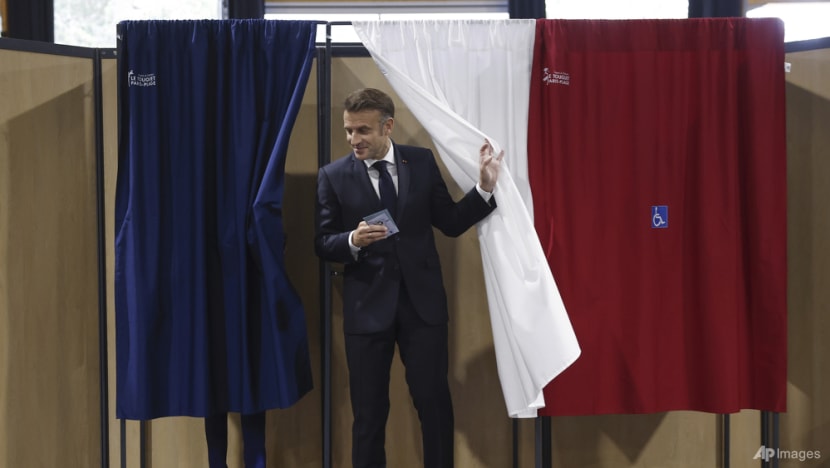CNA Explains: France's election has ended in a hung parliament. What happens next?
How was the far-right surprisingly thwarted, and what does it say about the wider picture in Europe?


This audio is generated by an AI tool.
A shock result at France’s legislative election on Sunday (Jul 7) has put the nation on course for a hung parliament.
The left-wing New Popular Front (NFP) alliance won the most seats in the National Assembly, following tactical voting that thwarted an expected victory by the far-right National Rally (RN) party and its allies.
However, its 182 seats fell short of the 289 needed to secure an outright majority in the lower house.
French President Emmanuel Macron’s centrist Ensemble alliance meanwhile secured 168 seats.
Marine Le Pen's nationalist RN – widely projected to win – managed 143 seats.
As none of the blocs won enough seats to form a majority, they will need support from others to pass legislation in a fragmented parliament.
Why was it a surprise and how did this happen?
This came after historic gains by the far-right in the first round of elections held on Jun 30, with RN leading its allies to sweep 33 per cent of votes. The NFP was in second place then with 28 per cent, and Ensemble lagged with 20 per cent.
For the second round of polling of Sunday, the left and centrist alliances cooperated by pulling candidates from three-way races to build a unified vote against the far-right.
Most races then became two-way contests, pitting a far-right candidate against a left-wing or centrist one.
And the youth vote was critical in causing the upset, said Jason Moyer, a Global Europe Program associate at DC-based think-tank Wilson Centre.
Multiple campaigns targeted at young voters warned of the potential dangers of a right-wing government, and urged them to go to ballot boxes.
France recorded a voter turnout of about 60 per cent – its highest since the 1980s.
The result was the left-wing swooping in with a last-minute resurgence to grasp the most seats.
Moyer pointed to the far-right’s roots in Euroscepticism and policies around anti-immigration and anti-North Atlantic Treaty Organization (NATO), and how these forced centrists and leftists to work together - even by sacrificing their own candidates in some cases.
“This was the result of carefully orchestrated political manoeuvres … pulling Macron’s centrist candidates to allow the left-wing coalition wins and keep out the far right,” he told CNA’s Asia First.
Could coalitions be formed?
The French president’s gamble has left the nation in political limbo.
Parliament is now divided into three major groups – the left, the centrists, and the far-right – with vastly different agendas.
With three years left on his term and unable to call for another election for the next 12 months, Macron is now tasked with forming alliances to run the country, with an unruly parliament.
Whether this could materialise is uncertain, said analysts.
French political parties don't have a culture of working in coalitions – there’s almost always been a clear majority.
Comments from political parties’ leaders so far have indicated lukewarm reception to working together.
Jean-Luc Melenchon, leader of the hard-left France Unbowed Party (LFI) that's part of the NFP cluster, said Macron must accept defeat and invite the NPF to govern.
Some centrist politicians from Macron’s camp have straight up ruled out working with LFI.
Meanwhile, RN’s president Jordan Bardella has accused Macron of pushing the country “towards uncertainty and instability”.
Cedomir Nestorovic, a geopolitics professor from ESSEC Business School Asia Pacific, noted that the different blocs made promises during the elections that are "practically incompatible with each other".
“Yet, they now have to work together and find common ground.”
Macron could decide who to form a government with, but it'll be subject to a confidence vote in the National Assembly.
Hence, it needs to be someone a majority of lawmakers can agree with.
Analysts said Macron was likely to try and form a centre-left coalition, but without the hard-left LFI. However, this would require the NFP to break up. For now, it remains unclear if the alliance will stay united and agree on what course to take. `
Amid this political gridlock, none of the three parties will be able to deliver their campaign promises, said experts.
This includes vows to the European Union that France will take control of its debt and deficit, said Nestorovic.
“If it's Macron's centrist party with its own coalition, we can expect to have a similar policy as in the past, but right now we don't know who is going to rule,” he said.
“The leftist coalition (wants) to fully apply their own programme. But I cannot imagine that Macron’s party, or those from the centre or right, will agree. If there’s a majority, they can deliver … but I don't think that will happen in reality.”
He added that while there was “huge uncertainty” at the moment, things will become clearer in weeks to come as the new Assembly finds some structure, and negotiations begin.
What does it mean for the wider far-right movement?
Analysts said results indicated the French’s determination to keep the far-right out of government, even at the cost of a hung parliament.
But at the same time, this doesn't discount fears of a far-right resurgence in Europe.
Across the continent, there have been breakthroughs by right-leaning nationalist and conservative parties in recent polls.
Last week in the UK, a left-leaning party won by a huge majority but some ground was also ceded to a hard-right faction.
Six out of 27 EU nations have far-right parties in government.
Perhaps most prominently, the Alternative for Germany (AfD) – which wants to curb immigration – has been gaining traction in German politics.
Moyer said that with the centre and left splitting votes, the far-right could continue to make gains.
“We are seeing a wave of far-right nationalism rising across Europe, with a larger than expected turnout of people supporting these parties,” he said.
“With this vacuum that exists, this is an opportunity for these populist leaders to rise and fill the gaps.”

















